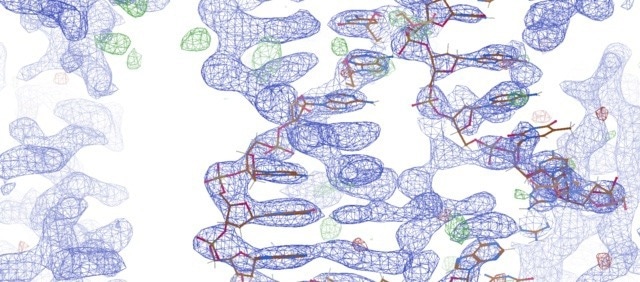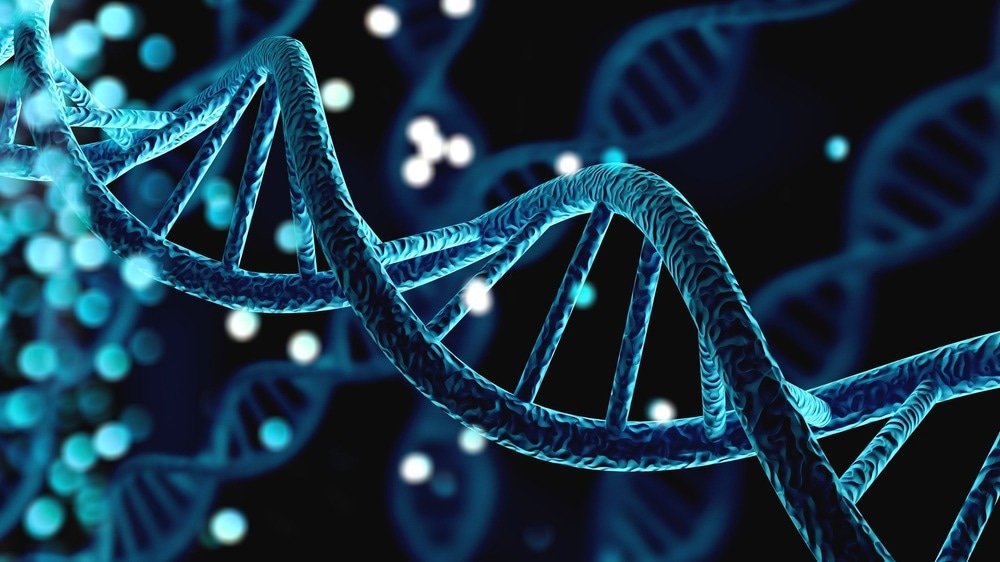Reviewed by Danielle Ellis, B.Sc.Jul 25 2023
West Virginia University researchers can now see synthetic DNA at the atomic level, allowing them to learn how to tweak its structure to improve its scissor-like function. Learning more about these synthetic DNA reactions could prove to be the key to unlocking new technology for medical diagnoses and treatment.
 WVU researchers have found a way to view synthetic DNA at an atomic level, which could ultimately lead to potential solutions for medical diagnoses and treatments. (WVU Graphic/Aaron Robart)
WVU researchers have found a way to view synthetic DNA at an atomic level, which could ultimately lead to potential solutions for medical diagnoses and treatments. (WVU Graphic/Aaron Robart)
In the field of science, the discoveries aid in resolving a 30-year-old query concerning this particular DNA structure and how scientists might catalyze it to generate a reaction without altering the DNA itself.
This is only, maybe, the third example lending insights, at the very detailed atomic level, into how chemically active DNA promote their unique functions that give all these applications their power. Atomic detail gives us a long-sought road map to start building and improving a technology that can be broadly applicable to health and diagnostics.”
Aaron Robart, Associate Professor, Department of Biochemistry and Molecular Medicine, School of Medicine, West Virginia University
According to Robart, if scientists can figure out how to make the technology work more effectively, it could be used to cure diseases like cancer or retinal degeneration.
The results of the study were published in Communications Chemistry, a journal in the Nature family.
The synthetic DNA utilized in the study, known as DNAzymes, is distinct from human DNA, according to Robart. DNAzymes are catalysts for chemical processes that can be produced in a lab at a low cost. They have undergone artificial evolution to carry out tasks including measuring soil heavy metal leaching and air quality monitoring.
Robart added, “Typically, we think of DNA as inert, serving as a storage unit for our genetic information. However, there are certain types of DNA evolved in the laboratory that defy the conventional rules. These DNAs can fold into complex shapes, enabling them to perform a remarkable range of reactions.”

Image Credit: Billion Photos/Shutterstock.com
He further noted, “The only problem is, after 30 years of research, we really didn’t have a clue on how any of the chemistry was happening. One of the big things we were missing is what our lab does with crystals, resulting in high resolution structures of what nucleic acids look like down to the atom detail and how they can do all this chemistry.”
Robart and his lab students, Evan Cramer of Lake Ann, Michigan, Sarah Starcovic of Cameron, and Beka Avey of Martinsburg, worked with the Advanced Photon Source at the Argonne National Laboratory of the US Department of Energy in Chicago to see DNA at the atomic level.
X-Ray crystallography is a technique that crystallizes synthesized DNA before zapping it with extremely powerful X-rays to show its structure. The team was able to operate the X-Ray and gather data online by collaborating with APS.
Using this information, we can better understand how other DNAzymes may behave in their cleavage reactions.”
Sarah Starcovic, Postdoctoral Student, West Virginia University
According to Robart, what they observed was a structure with small arms that could extend to grasp a piece of a complementary pattern and clamp themselves together, much like Velcro does.
Robart further added, “These DNAs can act as molecular scissors with precise specificity to cut RNA or DNA, or they can function as glue. Say you have a mutated gene that is causing disease, we could get this DNA into the cells and it would be able to get rid of all that kind of message that is causing the proteins that lead to the disease.”
Cramer, a PhD student in biochemistry and molecular medicine and the study’s lead author, expressed the expectation that more research will fill knowledge gaps for therapeutic applications.
It is difficult to improve something when how it works is not entirely known.”
Evan Cramer, Study Lead Author and Phd Student, Biochemistry and Molecular Medicine. West Virginia University
He joined the research team as a BridgesDH NSF-NRT Fellowship recipient and was most recently a Ruby Scholars Graduate Fellow.
The last phase, according to Robart, is to concentrate on diverse methods for catching DNAzymes at various stages of their activity.
Robart noted, “It will be like we are making an old school animation molecular flipbook. This level of detail is used to understand how to improve, target and regulate their activity. This is only one of hundreds of different varieties of DNAzymes, all with their own unique properties begging to be applied to topics in human health.”
He said that he also hoped to learn more about the potential applications of the model systems for treatments from his peers at the School of Medicine.
Robart concluded, “We are in a unique spot. We have a potential cure in search of a disease. I feel fortunate to be in an environment surrounded by so many talented collaborators in the School of Medicine to help this exciting technology reach its full potential.”
WVU School of Medicine researchers capture an atomic view of synthetic DNA
Sarah Starcovic, a West Virginia University doctoral student in biochemistry and molecular medicine from Cameron, conducts research in WVU School of Medicine Associate Professor Aaron Robart’s lab. The video includes more from Starcovic and others about work to view synthetic DNA at an atomic level. Video Credit: WVU Photo/Hannah Maxwell
Source:
Journal reference:
Cramer, E. R., et al. (2023). Structure of a 10-23 deoxyribozyme exhibiting a homodimer conformation. Communications Chemistry. doi.org/10.1038/s42004-023-00924-3